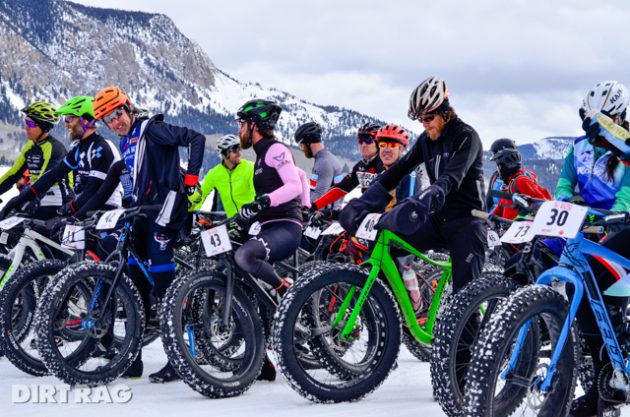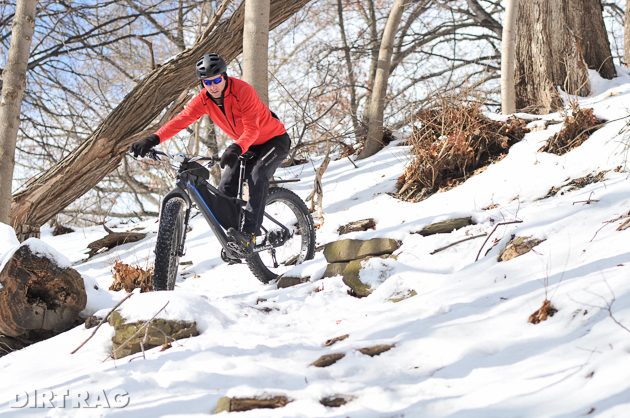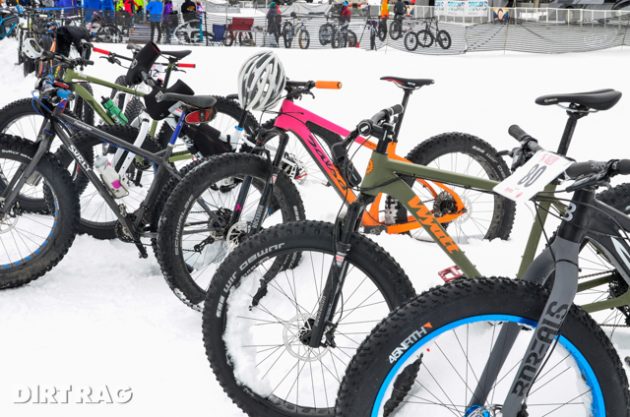Grooming fat: The fight for winter fat bike access
Originally posted on February 10, 2016 at 9:00 amWords: Sarah Galbraith
In parts of our country, when winter takes a firm, frosty grip on your core, some mountain bikers mark the turn of seasons by putting away their bikes and tuning up their skis. But explosive growth in winter fat biking has taken hold in the past few years: Sales grew 44 percent from 2013 to 2014, according to the Bicycle Product Suppliers Association, with nearly 38,000 fat bikes sold in 2014 alone. It turns out pedaling on two wheels is just too much fun to call it quits when Jack Frost comes a-banging.

As Andy Williamson, Great Lakes Region director with the International Mountain Bicycling Association (IMBA), puts it, “Fat biking is not a fad; it’s still mountain biking.” Mountain bikers in his neck of the woods, like Illinois and Iowa, are psyched to have an option to ride year round. “What we enjoy on mountain bikes in the summer is now also available in the winter season,” he says.
While the popularity of fat biking has exploded, the number of places to ride has not necessarily kept the same pace. When it comes to winter trails, many land managers and mountain bike advocates are still figuring things out. Folks in Colorado, Illinois and Vermont are working hard at developing new relationships and gaining trail access for fat bikes, and they’re all making progress in exciting ways.
The Same Access Fight
At first, bike shops were selling fat bikes like hotcakes but couldn’t really advise customers on where to ride, so they began sneaking onto groomed cross-country ski-touring center trails at night when no one was there to catch them. (They were riding snowmobile trails without permission as well.) They were also heading out on local ungroomed singletrack, often disappointed after struggling over a trail that was tracked out by snowshoers and dog walkers. None of this was terribly fun, so soon bikespecific snow singletrack became the goal among fat-bikers.

“We’re in the thick of it in terms of finding access for fatbikers,” says Mike Pritchard, executive director of the Roaring Fork Mountain Bike Association based in Aspen, Colorado, and associate region director for IMBA. “Our philosophy is ‘build it and they will come.’” Pritchard explains that his community’s goal is to create winter mountain bike trails rather than searching for access on existing trail networks. “We’re looking to provide a separate experience. Riding singletrack is more enjoyable than riding 8- to 12-foot-wide groomed Nordic tracks,” he explains. “Bikespecific singletrack is the goal. That will give everybody the best experience possible.”
To achieve this, Pritchard believes fat-bikers have to do the same thing mountain bikers did a few decades ago to gain summer access. In the ’80s, bikes were used to explore existing routes in forests and beyond, generally on public lands, much in the same way the first fat bike riders took to established winter routes. When the administrative decision came down to exclude mountain bikes from legislated Wilderness areas, mountain bikers got organized and worked with land managers to find places for trails that were sustainable, catered to a broad ridership and provided the best experience.
Now, Pritchard says, fat-bikers need to organize in the same way: “We need to join together so it’s clear to land managers that this is not a fad, and that providing great fat bike experiences is a truly worthwhile cause.”

His community is working on access to naturally groomed trails that are currently used by skiers and snowshoers, skirting town on public and private land. They’re also working with National Forest land managers to develop fat biking on federal land, where snow compaction is an issue for wildlife management. His group thinks fat bikes could be added to National Forest areas with existing compacted routes such as roads and snowmobile trails, and National Forest staff are planning an environmental analysis of the issue.
The Global Fat Bike Summit and Festival, held in January 2015, brought together fat bike advocates and land managers, including staff from the National Park Service, Bureau of Land Management and various state parks. The summit was held in Jackson, Wyoming, where local U.S. Forest Service staff have been progressive with fat bike policies.
But other public and federal areas, like Grand Teton and Yellowstone national parks, have banned fat bikes. The takeaway message of the summit is that this is not going away. For riders, fat bikes mean new trails and new terrain to ride. For bike shops, fat bikes allow them to still be bike shops through the winter, rather than laying off staff or switching to skis. But for land managers, it’s a new user group to manage, and new strategies are needed.

Pritchard says that quickly evolving fat bike technology can help the case for winter access. For example, tires have gotten wider and can run lower pressure. This means less compaction, which is important when sharing trails with other users, as on groomed Nordic trails, or riding in natural areas. Suspension forks are increasingly available as well, making riding on naturally groomed trails smoother.
“This technology can lend itself to better access, compared to bikes from 10 years ago,” says Pritchard. Plus, smaller-wheeled fat bikes for kids were added to the market last year, and that should help more families get out on the trails.
Getting to Know Snow
“Winter riding was already happening when fat bikes came along,” says Matt Andrews of his home state, Minnesota, where he’s executive director of Minnesota Off-Road Cyclists (MORC) and an assistant region director with IMBA. “MORC already had winter cycling, so when fat bikes came on the scene we just started grooming trails we already had.”
MORC maintains 50 miles of winter singletrack that exists in six public parks. Fat-bikers share the trails with snowshoers and runners. They don’t share trails with snowmobiles because there is a concern about the safety of combining motorized and non-motorized use, particularly in the dusk and evening hours.
Andrews also believes it’s important for trail maintainers to learn snow science. Learning how to groom is a big deal, and it can take years of experimenting to learn when to groom and what tools to use in different snow conditions. His group learned about grooming by connecting with the local Nordic community. “They understand when to groom,” he says. “If there is fresh snow, they’ll groom at midnight and let it set for four, six or 12 hours to get it solid.”
The key to good grooming is to fluff the snow to get the air out and then pack it down with something heavy. On trails where they can use motorized equipment, MORC employs a Yamaha Big Wheel, which is a fat-tired motorcycle. A club member who is handy with a welder designed their own grooming implements to attach to a hitch behind the motorcycle. “One looks like a big cheese grater,” Andrews says.

Where motorized use is not allowed, snowshoers will pack in the trail and drag truck tires behind them. In northern Minnesota, a group called The Snowshoe Zombies packs in winter singletrack by snowshoe. “These are athletic, CrossFit-type people,” according to Andrews. They snowshoe in a line, sometimes walking sideways, up and down the hills. “They’re Jazzercising down the trail,” he laughs, “working it out, and that makes beautiful singletrack.”
But snowshoe grooming takes a tremendous effort and works only where there is a dedicated group of volunteer snowshoers or runners. Aside from grooming advice, Andrews recommends that mountain bike groups think about winter when they’re proposing new trail projects and maintaining existing trails.
For example, trim tree branches higher when building trail to accommodate for the extra height of snow. Look at features like berms, double jumps and drops and think about how they will ride in the winter, or how they can be improved upon with snow. Because snow is a more durable surface, trail builders can break the rules a bit when designing winter trails.
Sharing Is Caring
When fat bikes first came on the scene, Vermonters were finding their own places to ride, legal or not. But in the last couple of winters, Vermont has been adding fat bikes to existing summer and winter trail networks, and the shared-use model is working. Kingdom Trails in East Burke, Vermont, which sees 60,000 summer mountain bikers per year on its vast network of singletrack, switches to a cross-country ski-touring center in the winter.

But in recent years the nonprofit organization that maintains the trails has been encouraged by the popularity of fat biking, so they added it to their winter operations. A 12-mile network of singletrack is snowmobile and snowshoe groomed by the trail crew, and last winter they had 2,500 fat-bikers ride there.
The Jay Cloud, a full-service bike shop located near Jay Peak Resort in Montgomery, Vermont, just added a winter bike shop at the mountain. Co-owner Ethan Dull got excited about his own fat bike last season and talked to the operations staff at the ski resort; management saw it as an additional recreation opportunity that would bring more people to the mountain. Everyone was happy to bring more people to the Nordic trail network, which hadn’t been seeing a lot of skier traffic.
Plus, fat biking complements skiing, says Dull: “On crappy ski days, the trails are great for riding.” Dull moves his bike shop to the Nordic center at the mountain for the winter and offers sales, service and fat bike demos and rentals. Fat-bikers have access to nearly 12 miles of Nordic ski trails and about 2 miles of snowshoe-groomed singletrack. He also likes to set up his demo fleet at the base of the mountain on a nice day and says the bikes get a lot of attention. “Most people have never seen or heard of these things, and once they see them they want to get out and try it.”

Dull also gets a lot of attention just biking around the base area to get coffee or run errands. Last year was particularly stellar when it comes to fat biking events in Vermont. New England’s fat bikers enjoyed Le Grand Fat Tour, a six-event series organized by Mountain Bike Vermont. The events spanned the Vermont-Quebec border and drew in 1,000 participants. Winterbike at Kingdom Trails was the culmination of the series, with 400 people joining the ridiculously fun daylong festival of riding, drinking, food and music. Plus, the Stowe Derby, a nutty downhill ski race that combines cross-country and downhill ski racing on old-school gear, welcomed 100 fat-bikers to the start line in 2014, marking the event’s 70th anniversary.
Vermont Mountain Bike Association’s (VMBA) executive director, Tom Stuessy, has been working tirelessly on winter access. Plans are in the works for an interactive online trail map, which this year will show 15 to 20 areas with open access for bikes, and expanding access is also at the top of the agenda. “VMBA’s been working very closely with public-land managers to find more and better access in Vermont,” says Stuessy. A new partnership among VMBA, the Vermont Association of Snow Travelers (VAST) and the Vermont Department of Forests, Parks and Recreation has invited five VMBA chapters to allow fat bikes on groomed snowmobile trails that are on state land.

“The point is not to provide long, 20-mile corridors of shared snowmobile trails,” says Stuessy. “The partnership is based on an understanding that we want access to the corridor to connect other fat bike riding areas.” To support the partnership, riders across the state will join local VAST clubs and will pitch in with trail maintenance and signage.
The Future Is Not Frozen
Clearly the number of places to ride your fat bike is on the rise across the country. Williamson, IMBA’s region director working in the Great Lakes area, thinks the winter fat bike access fight will be expedited, since this is just mountain biking, after all, and we’ve already come a long way with summer access. Yet he sees a future of providing trails on public land where people live that are purpose-built for fat bikes. He expects more ski resorts will add groomed fat bike trails in the coming years as well, since those riders represent a new market. To help all of this happen, he says, “We need to talk up the benefits of winter mountain biking.”